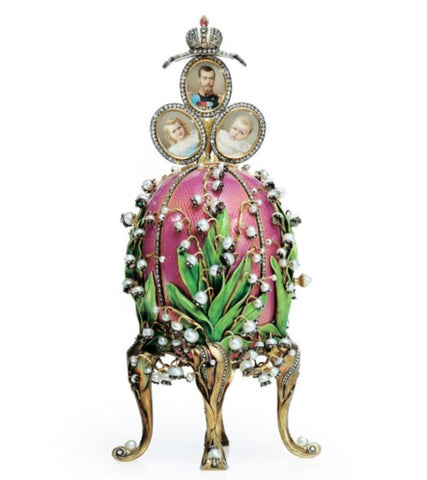Fabergé: the goldsmith who created the most expensive eggs in the world
Jewelry, watches and perfumes, the name of the House of Fabergé is indissociable from the famous Fabergé eggs, true works of art that reach astronomical prices and are coveted by collectors around the world.

A great name in Russian goldsmithing and jewelry, Pierre-Karl Fabergé is nevertheless of French origin on his father’s side and Danish on his mother’s. The family had to flee France following the revocation of the Edict of Nantes, leading them to live in the Baltic provinces in 1800 before joining St. Petersburg in 1830.

History oh the House of Fabergé
Born on May 18, 1846, Pierre-Karl Fabergé grew up surrounded by jewels thanks to his father (Gustav Fabergé) who was a renowned jeweler first in St. Petersburg and then in Dresden, when the family moved there in 1860. Pierre-Karl Fabergé studied at the School of Arts and Crafts in Dresden, then in 1864, he went on a grand tour of Europe during which he completed his training with renowned jewellers and goldsmiths in Germany, France and England. He returned to Dresden in 1872 to take over the reins of his father’s firm, having one of his father’s apprentices as a mentor.
After the death of his mentor in 1882, Pierre-Karl Fabergé received the title of Master Goldsmith. In addition, his brother Agathon, a renowned designer who had also attended the École des Arts et Métiers, joined the family business at that time.
The House of Fabergé then diversified and turned to costume objects in addition to jewelry.
During the All-Russian Exhibition of 1882, held in Moscow, Agathon and Pierre-Karl received the medals of the Exhibition and of Saint-Stanislas.
Upon seeing a replica of a gold bracelet from the 4th century B.C. at the exhibition, Tsar Alexander III said that he could not tell the replica from the original and decided to exhibit the Fabergé works in the Hermitage Museum as contemporary handicraft. He also ordered cufflinks in the shape of cicadas for him and granted him the privilege of being a supplier to the Imperial Court in 1884. Although this privilege continued during the reign of Nicholas II, he also conquered the courts of Thailand, Norway, the United Kingdom and Sweden.
However, the Russian revolution in 1917 forced Pierre-Karl Fabergé to leave Russia, as his name was associated with the Empire. He died in Pully, Switzerland, on September 24, 1920 at the age of 74.
His 4 sons were also jewelers for the House of Fabergé, as well as one of his grandsons and his great-granddaughter Tatiana Fabergé.

The Fabergé egg : creating a work of art
Although the House of Fabergé was first and foremost a jewelry house, today the name is undeniably associated with the famous Fabergé eggs. Fabergé eggs are incredible and marvelous precious objects, halfway between absolute luxury and a work of art. They fetch very high prices and are sought after by the most fortunate collectors.

The creation of the first Fabergé egg
In 1885, Tsar Alexander III commissioned Pierre-Karl to create the very first Easter egg for his wife Marie Fedorovna. The egg was made of white enamel, but contained a small multicolored hen in gold and a crown with a small ruby egg. Each year the Tsar ordered one for his wife. At his death, his son, Tsar Nicholas II, took over his father’s tradition and offered one every year to his mother and his wife.
52 imperial eggs would have been made by the famous goldsmith, that being with the Russian revolution of 1917, 7 are still missing today.

The most expensive Fabergé eggs
Many jewelry experts agree that the Fabergé eggs are handcrafted feats, emblems of art nouveau and precursors of art deco.
Today, these eggs are collector’s items and sell at extremely high prices in auction rooms, as was the case in November 2007 at a Christie’s sale where a Rothschild egg was sold for 12.5 million euros. The price of some Fabergé eggs even exceeds 20 million euros, such as the Carriage egg (1897) estimated at 22 million euros by Sotheby’s or the blue enamel egg with ribs (1887) sold for 24 million euros.

The Fabergé egg : a work of heritage
The secret of the Fabergé eggs has always been jealously guarded by their creator, a real legend was created around these objects of art and they are now part of the artistic and cultural heritage of the world. At the origin of many stories and intrigues, Fabergé eggs are often mentioned in books or movies. In fact, Fabergé eggs are recurrent in our favorite sources of entertainment and have been for a few years. Here are a few examples:
– In the movie, Ocean’s twelve, the dreaded thief Toulour challenges to steal a Fabergé egg.
– In Intouchables, Driss, the character played by Omar Sy, steals a Fabergé egg after his job interview.
– In the 5th episode of season 3 of Peaky Blinders, a Fabergé egg is used as a means of payment to smuggle armored vehicles into Russia.
Whether you're interested in buying a piece of jewellery or a stone, a free jewelry appraisal or jewelry resale, Pierres de Julie welcomes you to its Parisian boutique in the Village Suisse, a stone's throw from the Ecole Militaire and the Esplanade des Invalides.













